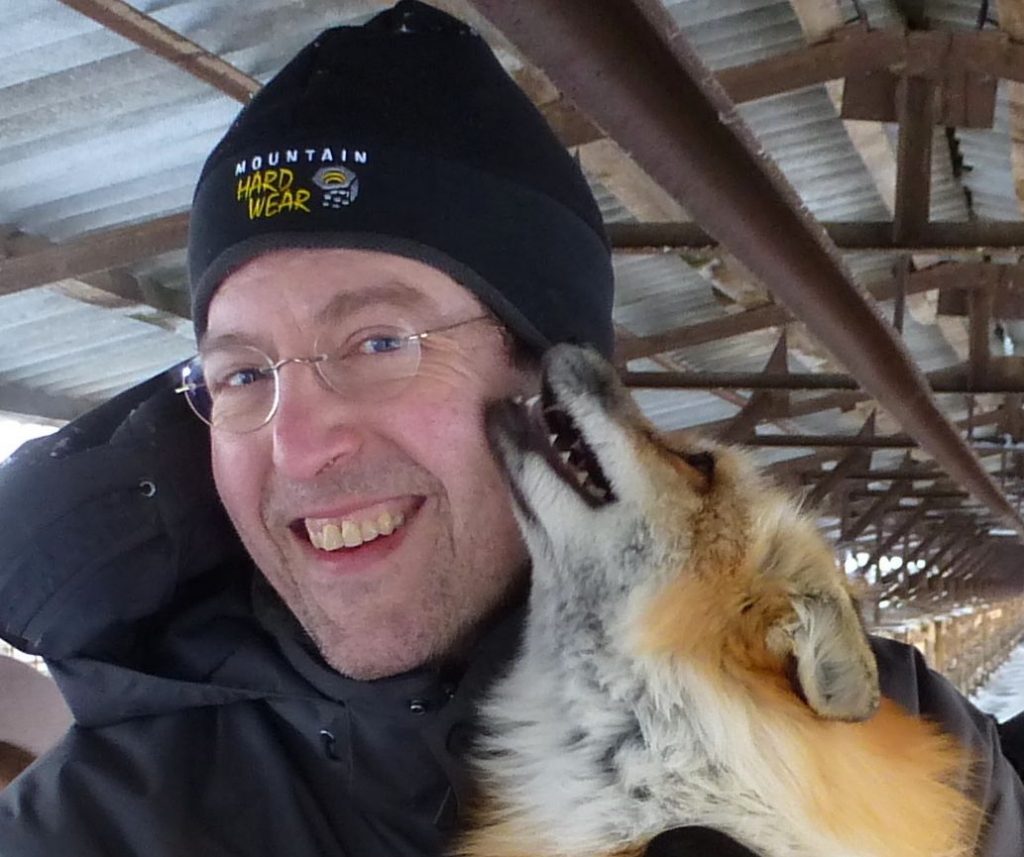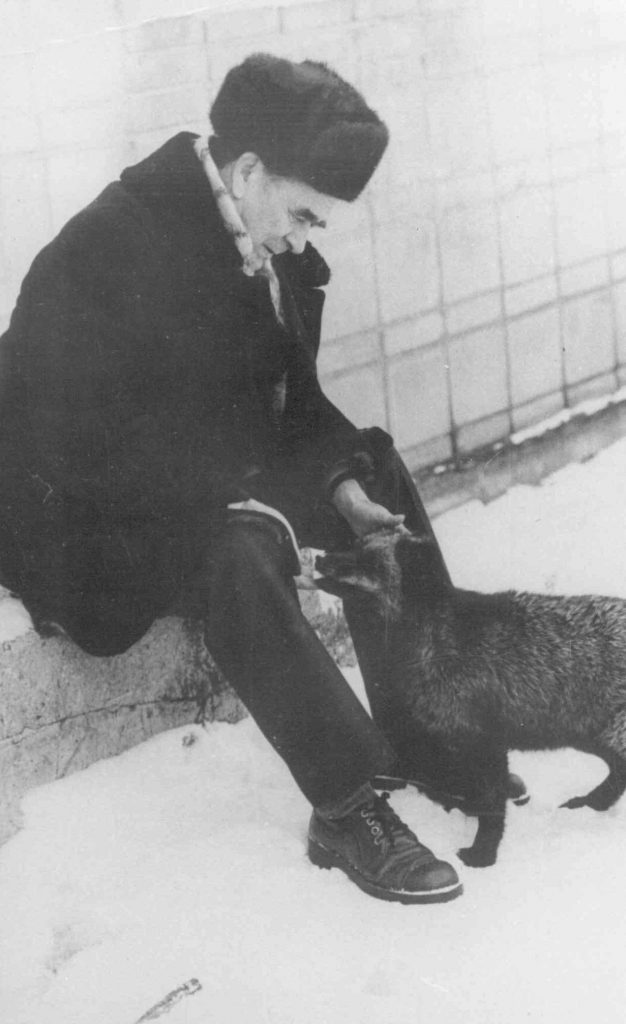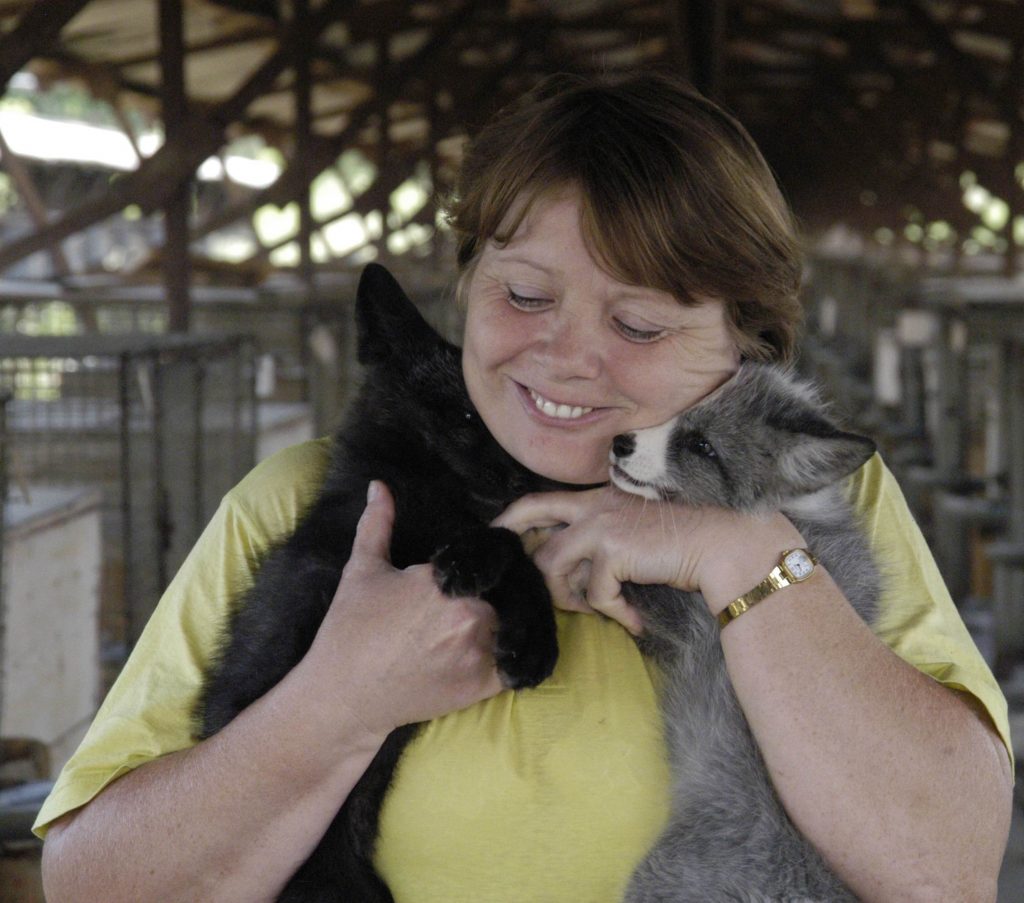From ‘fire-breathing dragons’ to the perfect pets. An amazing story on evolution
What would you say if we told you Russian scientists created the cutest, most adorable and lovable dog? It took them over 50 years to do so but their remarkable results have astonished the science world. The catch is they’re not actually dogs. They’re foxes. And the man who tells the story of ‘How to tame a fox (and build a dog)’ shared his amazing experience witnessing this evolutionary process sped up by thousands of years.
Renown evolutionary biologist and science historian Lee Alan Dugatkin, from the Department of Biology, University of Louisville, has travelled the world to tell the story of how wild foxes were tamed in Siberia, and EvoNews caught up with him to hear the fascinating tale.
Dugatkin was involved in the experiment as a historian of science, being interested in the whole story behind the work the scientists did. He first went to Siberia in January 2012 – facing -40 degrees Celsius – and then returned in 2014. He and Lyudmila Trut wrote ‘How to tame a fox (and build a dog).’
On getting to know the foxes, he says:
“To actually go interact with the animals was unbelivable. They’re more friendly than the friendliest dogs that you can imagine. It’s striking how much like a dog they look.”

The story of how foxes were turned into ‘dogs’
Back in the 1960s, Russian biologists Dmitri Belyaev and Lyudmila Trut set out to do an amazing thing – speed up thousands of years of evolution into just a few decades. Belyaev, who was a geneticist and academician who served as director of the Institute of Cytology and Genetics (IC&G) of the USSR Academy of Sciences, Novosibirsk, basically wanted to run a real time domestication experiment.
He chose foxes because the animals were used in Russia for their fur, and this gave the scientist the perfect cover-up for his experiments – as at that time Trofim Lysenko, a Soviet agrobiologist with anti-Darwinian doctrines, had Stalin’s ear and scientific dissent from his theories was outlawed.
Lyudmila Trut was at that time the young, vibrant scientist, who Belyaev trusted to run his experiment. She started her work at a fox farm in Siberia, testing foxes’ reactions when she approached their pens, when she stood close to them and when she opened the pens and put food or other objects inside. Each of the hundreds of foxes tested was assigned an overall tameness score. The ten percent showing the best results were selected for breeding.
The ‘fire-breathing dragons’
“Lyudmila’s work would begin everyday at six in the morning, testing fox after fox after fox on how tamed they were around humans. She would see what the foxes would do as she approaches the cage, as she would stand by their cage, as she opened the cage and as she placed her hand in the cage. She would do anywhere between 50 and 60 foxes everyday for months. Then, a few months later, she would test them again, to see if they were persistent in their behaviour. When she had all the scores, she would take the top ten percent and those would be the parent of the next generation. The first generation was in 1959-1960,” Dugatkin says.
According to the renown evolutionary biologist, at first, these foxes were anything but tamed. The vast majority of them were aggresive or, at best, neutral, very few showing any close social behaviours. As Dugatkin says, Lyudmila reffered to most of the foxes as ‘fire-breathing dragons.’
But Lyudmila didn’t lose hope, and she had good reason to do so – she noticed that even a couple of years into the experiment, some of the workers at the fox farm were beginning to bond with the calmer foxes from the second and third generations. One of the female workers even shared her breakfast with some of the foxes.
“This wasn’t part of the experiment, but Lyudmila couldn’t help but notice how the bonds were formed, and this was important because this kind of bonds were probably critical to the early domestication of dogs. Now she was seeing this in foxes,” Lee Dugatkin says.
Because the experiment was beginning to work, what constituted calmness in foxes was changing. As such, in order to make the ten percent, the selected foxes in the fifth generation had to be a lot tamer than the first ones that were selected. In order to keep things in check, Lyudmila devised a ‘class’ registry – with the ‘Class I’ foxes being friendly towards humans, whining as humans approached or left, wagging their tails. Just a year after that, the scientist had to come up with a new class – ‘Class E’ (elite) – as these foxes showed all the above signs, but even licked the human’s hand in a dog-like fashion. Even more, they were wagging a much curlier tail that is present in a wild fox.
“So they were not only becoming much calmer, they began to show those other traits that we see in domesticated species. Curly tails that are wagged in presence of humans is a classic thing that you see in many domesticated species. But the key thing is that Lyudmila and her team never chose a fox based on whether or not they were wagging their tail or had a more curly tail. It was simply based on how they behaviourally responded when humans came by. So they were only selected them on behaviour, never on morphology,” Dugatkin explained.
A couple of years later, Belyaev managed to find the money to build his own experimental farm where he and Lyudmila could do their work. Soon after, in 1967, as Dugatkin says, something really special happened. In a normal fox, until they’re two or three weeks old, their ears are floppy. But then their ears straighten out. But int he case of a fox named Mechta (‘Dream’ in Russian), her ears stayed floppy well after three weeks. As a matter of fact, the fox’s ears were floppy even when she was two month old. And they never straightened out.
“When Belyaev came and saw Mechta, the first of the domesticated foxes with truly floppy ears, she asked Lyudmila ‘what kind of wonder is this?’. When the two went to conferences and talked about the domestication experiment and showed pictures of Mechta, everybody accused them of making it up, saying it was just a dog puppy. That’s how much Mechta looked like a puppy,” Dugatkin says.
By now, the two scientist had foxes with all the traits of a domesticated animal – calm animals with floppy ears and curly tails that they wag around humans – but their experiment still went on based on the same rule: selecting the foxes only based on behaviour.

In 1974, the stress hormone levels were 50% lower in the domesticated foxes compared to the wild ones. But apart from being less stressed than in their normal environment, the foxes were also ‘happier,’ as they showed higher levels of dopamine and serotonin, associated with positive moods. On top of that, scientists found that the pups opened their eyes earlier than usual and responded to sound faster. Lyudmila said about these changes that it’s ‘almost as if they’re just so excited about interacting with humans that they want to start faster.’
The cross-fostering experiment
Scientists at one point started to experiment something different too. In addition to having the domesticated foxes, they had another line of foxes selected based on how aggressive and anti-social they were to humans. This allowed them to mate the aggressive foxes with the domesticated ones and see the results. Also, it helped them make sure of the evolutionary process.
“Any time you do an evolutionary experiment, when you select animals based on their behaviour, you’re always worried that somehow something non-genetic is affecting those result. The only way you can know for sure is to run a certain kind of experiment, one that is known as a cross-fostering experiment. Lyudmila would work with pairs of foxes and each pair would have a tamed female that was pregnant and an aggressive female that was pregnant. When the developing embryos were just a week old, she transferred them from one uterus to another. So half of the embryos in the uterus of each of the foxes was from the other,” Dugatkin explained.
So, when the female gives birth, do those pups behave like their biological mother or do they behave like their foster one? If their behaviour is genetic, then tamed pups should be tame regardless of whether or not they stayed in their tamed mother’s uterus or have been transferred and developed in the uterus of the aggressive female. The same goes for the aggressive pups. That is, these aggressive foxes behaved like their aggressive biological mother.
But there was a problem – when Lyudmila transferred the embryos she knew which was which. But how would she know when the pups were born? The answer lays in the appearance: fur coloration is a genetic trait in these foxes, so if they knew the fur coloration of the parents, the scientists could select them and know the future colour of the pups.
Lyudmila and the other workers were waiting for the foxes to give birth and the pups to get big enough to start walking around and interact with humans. She described the results:
“It’s fascinating. The aggressive mother had both tamed and aggressive offspring. Her foster pups were not only walking, but if there was a human standing by they were rushing to the cage doors, wagging their tails and licking my hands. The mother was punishing the pups for such an inappropriate behaviour. She growled at them, grabbed their neck and threw them at the back of the cage after they were friendly with humans. And they immediately got back up, went back to the front of the cage, started wagging their tails and licking my hands.”
They were behaving the way a tamed fox behaves, even though the aggressive female was the one who gave birth to these offspring. It was exactly what they wanted to see.
The same happened with the aggressive pups born by the tamed female. And it happened over and over, giving scientists strong evidence that it was due to changes in the genes associated with behaviour.
“You become responsible forever for what you’ve tamed”
By the mid 1970s, it was really clear that the experiment was working and every generation of foxes was tamer. But Lyudmila wanted more. She wanted to see just how far down the path of domestication these foxes have come. And so she suggested to Belyaev to move into a new house with a pregnant tamed female and live with that fox 24 hours a day, 7 days a week, for months, maybe years, the way people live with their pets. It was going to happen just once, but Lyudmila thought it was critical for the experiment to take place, as usually, the foxes would not interact with humans all the time.
Belyaev agreed and so, in March 1975, Lyudmila moved in with Pushinka (Russian for ‘tiny ball of fuzz’), a pregnant tamed fox, the calmest of her generation.

The house they moved into had three rooms, one of them being Pushinka’s room. Anybody, the fox or Lyudmila, could move anywhere they wanted in the house. The house had a yard in the back, where Pushinka and her pups played anytime they wanted. Lydumila interacted with the foxes the way humans interact with a dog: she played ball with them, ran up and down the hills with them, walk them around in leashes, they would respond to her names and if she would whistle they would come. And while she took notes of everything that was going on during the three-month experiment, Lyudmila could be more than just a meticulous scientists and call the foxes names and play with them.
One night, as Dugatkin says, something incredible happened.
While during the time Lyudmila and the foxes lived in the house there were a number of people visiting – from other scientists to other humans – none of the foxes was aggressive. Then, on 15 July, Lyudmila’s life was changed by what happened.
“Every evening, Lyudmila would go to a bench that was by the other side of the house and she would sit and read. Every night, Pushinka would lie down right next to her. At this time of the day, there was a guard that worked at the experimental farm and he would patrol the area. The guard who came by on July 15 was new. Nobody knew who this guard was. When this stranger began approaching Lyudmila quickly, Pushinka jumped up, began running full speed towards this intruder and she did something Lyudmila never heard a fox do before, or after that. That was to bark at this intruder, exactly they way a guard dog would do if they thought their master was in trouble. Lydumila was convinced that was what Pushinka was doing and the reason she is convinced is because Pushinka did not only do that, but when Lyudmila walked at the guard and began to talk to him in a calm way, and Pushinka could see she was not in any danger, she stopped barking, went back to the bench and sat down,” Dugatkin says.
Lee Dugatkin says the experiment had such an impact on Lyudmila she will never forget the time she spent with Pushinka and her pups in that place.
“Now the house is just rubble, but I walked in the house with Lyudmila and it was like stepping into the past. She remembered everything that happened,” Dugatkin says.
The experiment was also the reason Lyudmila decided to continue the experiment for the rest of her life. Or, as the fox in The Little Prince puts it: “You become responsible forever for what you’ve tamed.”
The deaths of ’85
One of the most amazing result of the experiment was in regard to the reproductive process. The first signs appeared in the mid 1970s. While typically foxes go into estrus (breeding period) in late January, early February, and it lasts from a week to ten days, the domesticated foxes were beginning early and staying in estrus a couple of days later.
By the early 1980s the scientists were seeing even more changes in the reproductive system of the foxes. The foxes extended the breeding period a great deal. In ’84, some of the females not only extended their reproductive season they actually went into estrus a second time in September – one of the classic things of domesticated species. But in the case of the foxes, there were no males ready to mate with them.
A year later, as Dugatkin says, a few of the females went into estrus in September and male foxes mated with them. The females gave birth to a second clutch of pups, a dramatic change as the experiment was by then going on for just about 25 years, ‘nothing from an evolutionary perspective.’
“Something sad, but interesting happened, though. Females that gave birth in September had five or six pups, but none survived. The reason was that their mothers had much lower milk levels and they were not willing to give them milk. Lyudmila and the team tried to keep them alive but they all died. But they remarked how evolution operates bit by bit, where lots of things have to come together in order to work,” Dugatkin said.
This was the last major breakthrough Belyaev saw, as he died in 1985, leaving Lyudmila in control of the experiment.
The ‘laugh’ that still puzzles scientists
In the 80s and 90s Lyudmila and her team made measurements and concluded that the foxes began to look more and more like dogs than foxes, having much rounder snouts and juvenile features, with their bodies being chunkier and lower to the ground.
But according to Lee Dugatkin, one of the most fascinating traits only appeared around ten years ago, which means the experiment was going on for over 40 years, proof that such experiments need very long periods of time to show full results.
“It’s one of the things we’re likely to see one of our pets do,” Dugatkin says.
And this is it:
“If you take that and map it next to a human laugh, there are no animal sounds they have found so far that match better than this sound,” Dugatkin explains.
Scientists say they don’t know why and how the foxes started making the sound, but they concluded that it’s the perfect sound for a pet to make. And more and more foxes started making in the last years.
What’s happening with the foxes now
Lyudmila Trut is still running the fox farm experiment, even if she’s now over 80 years old. She wants to be able to register these foxes as household pets, not an easy thing to do. People from the U.S. and Europe have bought foxes from the experimental farm, around two dozens, but the foxes are considered exotic animals by law.
“This means that, depending on where they live, people can have or not have such a fox in their house,” Dugatkin says.
And the law is not the only obstacle – a domesticated fox from the Siberian farm can cost up to $8,000 or even more.

